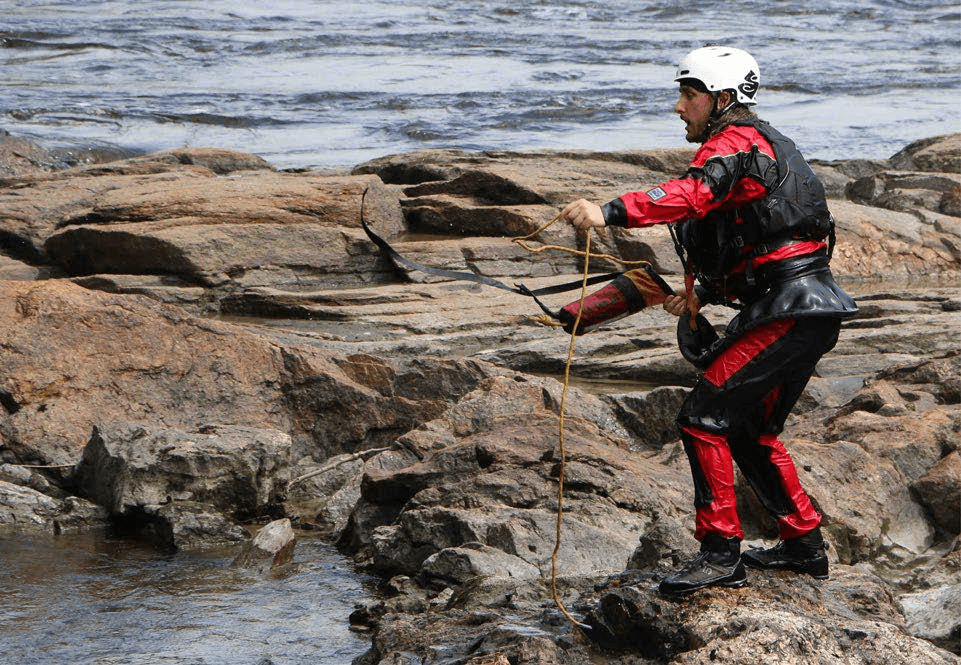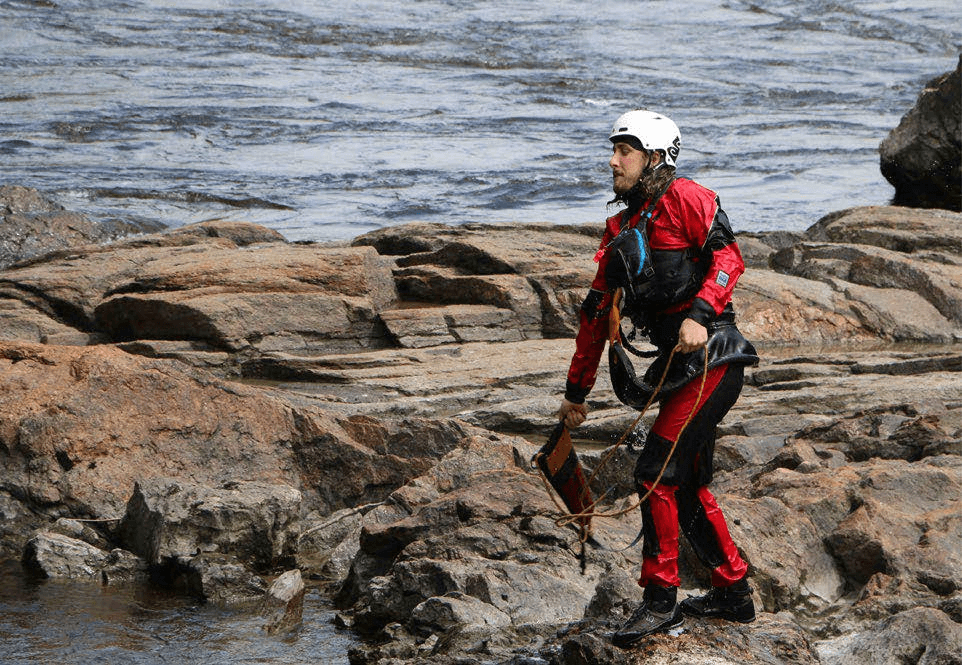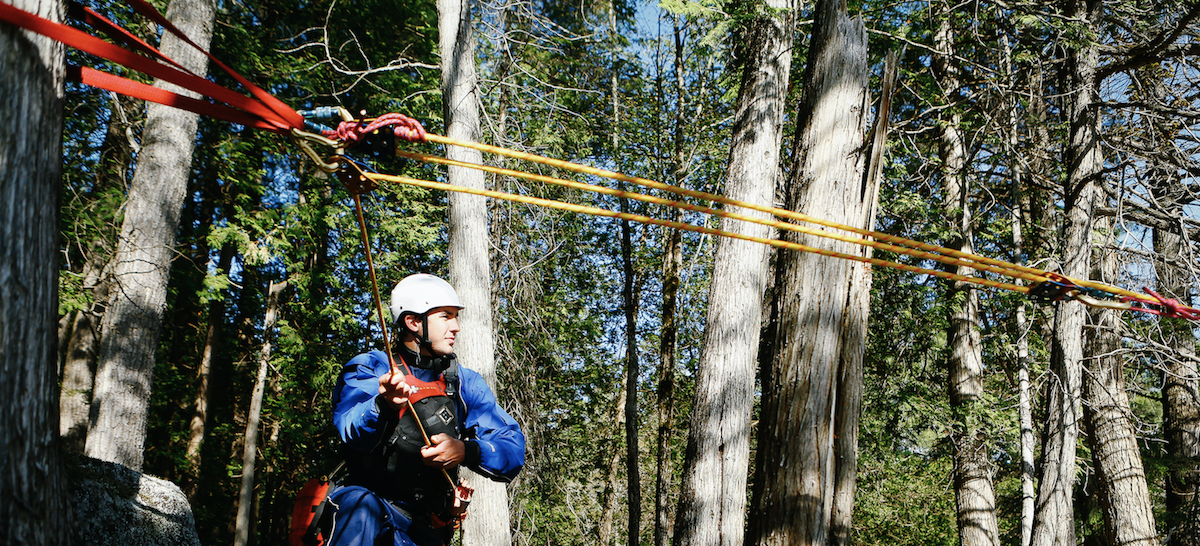Throw Bag Rescues
Important safety concepts and techniques for throwing ropes
Throw bags—and rope in general—can be super useful tools in river rescue. However, if you’re not very good at throwing throw bags, chances are, you’re unlikely be successful when the time comes to make it count.
Also, ropes in rivers are dangerous! If somebody gets entangled in a rope and the rope also gets hooked on a rock, the person can get pulled underwater and drown.
This article includes videos, text, diagrams, and links to additional posts. We’ll keep adding to it over time.
We hope you enjoy and can take advantage of this resource and remember, the key is practice, practice, practice.
Video: ‘Throw Bag Introduction’
Throw rope and throw bags
In its most basic form, a rope rescue involves a rescuer on shore, throwing a rope to somebody who’s inadvertently swimming in a rapid.
Use examples
- Throw to a subject or rescuer in mid-current and pendulum them to shore
- Tie to a piece of gear or a boat and pendulum it to shore or to another spot in the river
- Perform tethered rescues (AKA ‘live bait’ rescues—rope tied to a rescuer’s quick-release harness)
- Lining boats (using rope and the current to maneuver a boat in a rapid)
- Transport subjects and rescuers from one bank to another or from an island by penduluming them in the current
Throw rope characteristics
Throw ropes come in many different styles and designs. Throw ropes for whitewater usually are:
- Floating rope
- Length of 15-23m (50′ to 75′) in length
- Diameter of 6-9.5mm (1/4″ to 3/8″).
A thinner rope is harder to hold on to without getting rope burn and is not as strong, but smaller bags are easier to throw far.
Bag characteristics
The bag itself also needs to:
- Float
- Drain water
- Close properly
- Have attachment points other than the rope itself
Important safety principles
Throw ‘clean’ rope
Some throw bags are still sold with a big knot tied in the loose end of the rope. We recommend against this; throwing “clean” rope with no knots makes it less likely that the rope will get caught on something.
There have been drowning incidents where an individual has been tangled underwater in a rope with a knot ‘chalking’ between rocks on the river bottom – anchoring the rope and the entangled person to the bottom of the river.
Throwing from boats: usually a horrible idea
There’s an important point that we want to make clear: whitewater throw bag rescues are meant to happen from shore.
Throwing from a raft or any boat can lead to entrapment and have disastrous consequences. The risks of throwing from a free-floating craft in a whitewater setting almost always outweigh the benefits.
How to carry a throw bag
- Never attach a rope or even a closed throw bag to anyone without a quick release system.
- Throw bags may have an integrated or separate quick-release belt that allows them to be worn around the waist.
- Watch out for older style throw bags that have waist belts that are not quick-release.
- The quick-release buckle should be positioned at your side: if it’s at the centre of your abdomen, you won’t be able to access it if you’re folded over by the current.
- A throw bag can also be attached to the quick-release belt of a PFD.
- Clip to an attachment point on the throw bag near the top, so the bag is held upright. Don’t attach directly to the rope loop, since this holds the bag upside down, and the rope is more likely to fall out.
Only affix a throw bag onto your body with a quick release belt or harness, even when walking on shore.
When clipping the full bag to yourself or your craft to carry it around, use a loop or buckle on the bag and not the rope itself.
Video: ‘How To Carry A Throw Bag on Your Body’
Video: Instructor tips – ‘Rescue Gear Rundown: Pocket Throw Bags’
How to Throw — full bag, coils, and ‘split bag’
Full bag throws
People usually throw underhand or overhand with a straight arm. Practicing both throws allows you to have for versatility under low hanging trees, or from shallow water or bushes. For both types of throw, follow these steps:
1. Prepare to throw
- Pull out at lease 1.5m of rope (from the ground up to your shoulders)
- Hold the rope in your non-throwing hand
- Grab the top of the bag with your throwing hand (note: don’t just hold it with your fingertips—get a good hold with all your fingers and part of your palm and try with your thumb both inside and outside of the bag)
- Stand with knees bent, your throwing side foot back, and your non-throwing side foot forward like you are about to start running

2. Wind up
- Bring the bag back to shoulder height behind you
- Shift your weight to your back foot
- Bend your legs
- Bring your throwing side shoulder back to coil up your core muscle

3. Throw: a combination of swinging your arm, straightening your legs, and unwinding your torso at the same time
- Swing the bag and your arm forward, while keeping your elbow straight
- Push off with your back foot while straightening your legs
- Bring your throwing side shoulder forward to get power from you whole core

4. Release: Release the bag with your hand at around shoulder height and pointed towards the target
Note in the series of photos how the thrower gets power by:
- Bending then straightening the legs
- Rotating the torso with the throwing-side shoulder ‘winding’ back then ‘unwinding’ forward

Video: ‘How To Throw A Throw Bag’
Throwing coils
There are numerous ways to make and throw ‘coils’. Here are four methods that we often teach:
- Butterfly coils (starting from the rope end)
- Butterfly coils (starting from the bag end)
- TRU method
- Loop method
Video: ‘4 Ways to Coil Your Throw Rope’
‘Splitting the Bag’
When a long throw isn’t needed, you can split the rope in two. Coil half into the rescuer’s throwing hand and leave half in the bag. This allows for two throws within a few seconds.
Video: ‘The Split Bag Rescue—2 Throws in 2 Seconds’
Ttest
Split bag variation: The Handful Method
An awesome variation of splitting your bag — The Handful Method — allows you to throw your first throw even fast.
Check out this full article including a video of a real life example of The Handful Method in action
Positioning for throwing and catching
Where and when to throw
“Upstream and within range”
Throw while the swimmer is upstream and within range. This will give the rescuer time to get into a good position before the rope comes under tension. It will also make it more likely that the subject sees the rope coming toward them.
“To and through”
Throw the rope to and through the swimmer. A single strand of rope should land in the subject’s hand. The remainder of the rope and bag (or coils) should continue beyond them toward the middle of the river.
Catching a throw bag
The swimmer should grab the rope like a golf club, being careful not to wrap the rope around their hand. It’s important that the swimmer catching the rope, grabs the rope and not the bag itself. The reason for this, is because if you have a 50ft line in the bag, and the swimmer is only 10ft away, instead of coming back to the shore, the swimmer will now be floating another 40ft until the rope get’s under tension.
After catching, the swimmer is best positioned on their back, with the rope on the side of their body that is opposite to the shore from which the rope was thrown. This will create a ‘ferry’ angle, increasing both the swimmer and the rescuer’s ability to hold on. Having the swimmer on their back will also allow an open airway, allowing the swimmer to control their breathing while holding onto the rope.
Towing a subject
The rescuer holds the rope on their ‘correct’ side (opposite side from where the rope was thrown) while holding the subject downstream of them, their free hand grabbing the subject’s ‘correct’ shoulder strap (opposite side from where the rope was thrown) or wrapping the subject with their legs.Test
test
Rescue line and high-strength throw line
Your average throw rope
Many throw ropes are great for throwing to a swimmer and simple rescues where not a lot of force will be put on the rope. However, if there will be significant force on the line (examples: unwrapping a canoe or a loaded gear raft, advanced rope systems, etc.), these ropes aren’t strong enough and can break. This is where ‘rescue line’ comes in.
Rescue line characteristics
A rescue line is high strength rope needed for hauling and transportation systems involving highly tensioned lines and/or high amounts of force.
Some examples of situations when a rescue line is needed:
- Haul on a wrapped or pinned boat
- Tensioned lines for transport systems
- Vertical rescue systems (rappelling, ascending, raising and lowering systems)
- Vehicle stabilization lines
Important characteristics of a rescue line
- High strength
- Low stretch (sometimes called ‘static’)—unless being used for lead climbing, in which case it should be high stretch (sometimes called ‘dynamic’) to ‘absorb’ a big fall
- High abrasion resistance—so it doesn’t easily get cut when rubbing on itself, other ropes, rocks, etc.
- High melting point
- Diameter
Most high angle rescue teams use ‘life safety rope’ with a diameter of 11mm (7/16″) or greater. But these days, there are plenty of very strong ropes at much smaller diameters—used when weight and space are a concern.
Construction
Most rescue line is kernmantle rope—meaning it has a core of long strands (which provide the high strength) wrapped in a sheath (to protect to the core). The name kernmantle comes from the German ‘Kern’ for core and ‘mantel’ for sheath.
There are many types of rope construction that can make for strong rope. You can see more examples, descriptions, and diagrams in this article by a rope manufacturer.
Materials
For years, nylon was the material of choice for rescue line. However, these days, a multitude of materials are used in rescue ropes for their various properties (strength, weight, stretch, heat resistance, UV resistance, water resistance), including nylon, Dyneema, UHMWPE, polypropylene, Technora, polyester, and more.
You should know and understand that Kernmantle ropes often combine two or more different materials to benefit from their various properties (example: abrasion-resistant sheath + high strength, flexible, and floating core).
Throw rope + rescue line = “High Strength Throw Line”
For river runners and rescue teams where weight and space are important factors—we recommend combining rescue line and throw rope into one, multi-use, piece of gear: High Strength Throw Line.

The most common throw rope material is polypropylene: it floats well and works fine for throwing to a swimmer— and it’s relatively cheap. The problem is, polypropylene has a relatively low melting point, stretches, isn’t very abrasion-resistant, and isn’t very strong…
…all of this means it isn’t good for much beyond throwing to a swimmer.
Some organizations and individuals carry cheap throw bags and then separate rescue lines.
However, the idea with high strength throw line is that it’s good for throwing and strong enough for other applications. If one high strength throw line isn’t long enough, you can attach two or three together to get across wider channels.
So what constitutes a high strength throw line?
- Floating rope
- Small enough to carry easily and be good for throw rescues—less than 9.5mm (3/8″). These days ours is 8mm (5/16″) though we’re looking for a good 7mm option
- Typically kernmantle construction
- Greater than 13.5 kN (3000 lbf) minimum breaking strength (MBS)…but 20kN+ (4500 lbf+) is even better
Combining these attributes makes for more expensive rope, but one that’s useful for multiple purposes.

